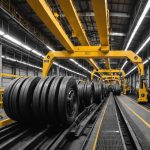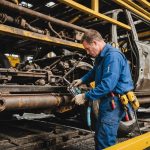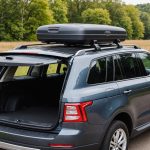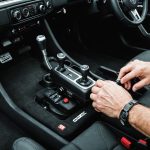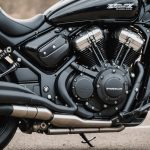Mastering Clutch Pedal Free Play: A Comprehensive Guide to Proper Adjustment in Your Manual Transmission Vehicle
Understanding the Clutch Pedal and Its Importance
When it comes to driving a manual transmission vehicle, the clutch pedal is one of the most critical components. It is the key to smooth gear changes, efficient engine performance, and overall driving experience. However, many drivers often overlook the importance of proper clutch pedal free play, which can lead to premature wear on the clutch and other transmission components.
The clutch pedal is connected to the clutch assembly, which includes the clutch disc, pressure plate, and release bearing. When you press the clutch pedal, it disengages the engine from the transmission, allowing you to change gears. The free play is the distance the pedal travels before it starts to engage the clutch mechanism.
Also read : Essential Guide to Safely Inspecting Vehicle Chassis for Corrosion: Best Practices Explained
Why Proper Clutch Pedal Free Play is Crucial
Proper clutch pedal free play is essential for several reasons:
-
Prevents Premature Wear: If the free play is too little, the clutch may remain partially engaged, causing unnecessary wear on the clutch disc and pressure plate. On the other hand, too much free play can lead to difficulty in finding the biting point, which is the point where the clutch begins to engage.
Also read : Essential Considerations for Optimizing Suspension Settings to Enhance Load Management
-
Ensures Smooth Gear Changes: The right amount of free play helps in smooth and precise gear changes. It allows the driver to feel the biting point clearly, which is vital for avoiding jerky starts and stalls.
-
Improves Driving Experience: Proper free play contributes to a more comfortable and controlled driving experience. It reduces the strain on the driver’s left foot and makes driving in heavy traffic or hilly terrain less tiring.
How to Check and Adjust Clutch Pedal Free Play
Checking and adjusting the clutch pedal free play is a relatively straightforward process that you can do yourself with a few tools.
Steps to Check Clutch Pedal Free Play
-
Locate the Clutch Pedal: Start by locating the clutch pedal in your vehicle. It is typically the pedal on the far left.
-
Measure the Free Play: Press the clutch pedal down slowly until you feel resistance. This resistance indicates the point where the clutch mechanism starts to engage. Measure the distance from the top of the pedal to this point. The recommended free play varies by vehicle but is usually around 1-2 inches (2.5-5 cm).
-
Consult Your Manual: Refer to your vehicle’s manual for the specific free play measurement recommended by the manufacturer.
Steps to Adjust Clutch Pedal Free Play
If the free play is not within the recommended range, you may need to adjust it.
-
Locate the Adjustment Mechanism: The adjustment mechanism is usually located at the clutch cable or hydraulic system. For cable-operated clutches, you will find an adjuster nut at the end of the cable. For hydraulic clutches, the adjustment is typically done at the master cylinder.
-
Loosen the Locknut: Loosen the locknut that holds the adjuster in place.
-
Adjust the Cable or Hydraulic System: Turn the adjuster to increase or decrease the free play until it is within the recommended range.
-
Tighten the Locknut: Once the correct free play is achieved, tighten the locknut to secure the adjustment.
Common Mistakes to Avoid
When driving a manual transmission vehicle, there are several common mistakes related to clutch use that you should avoid:
Leaving Your Car in Gear at a Red Light
Leaving your car in gear at a red light with the clutch pedal pressed down can put unnecessary strain on the clutch and your leg muscles. Instead, shift into neutral and apply the handbrake to keep your car stationary.
Resting Your Hand on the Gear Stick
Resting your hand on the gear stick while it is in gear can apply pressure to the internal components of the gearbox, leading to wear and tear. Always take your hand off the gear stick once you have changed gears and keep both hands on the wheel for safety.
Using the Clutch to Hold Your Car on a Hill
Using the clutch to hold your car on a hill can burn up the friction material on your clutch disc. Instead, apply the handbrake and use hill-hold assistance technology if available.
Practical Tips for Better Clutch Control
Here are some practical tips to help you master clutch control:
-
Find the Biting Point: The biting point is where the clutch begins to engage. Finding this point smoothly is key to avoiding jerks and stalls. Practice in a safe area until it becomes second nature.
-
Use the Clutch and Brake Together: When stopping on an incline, use the brake pedal and handbrake together to ensure your car does not roll back. This reduces the strain on the clutch.
-
Avoid Riding the Clutch: Riding the clutch, or keeping the pedal partially pressed, can cause excessive wear. Instead, fully release the clutch once you have changed gears.
-
Maintain Your Vehicle: Regular maintenance, including checking and adjusting the clutch pedal free play, can extend the life of your clutch and transmission.
Table: Comparison of Manual and Automatic Transmissions
| Feature | Manual Transmission | Automatic Transmission |
|---|---|---|
| Driver Involvement | Requires active engagement of clutch and gearshift | Minimal driver involvement; gears change automatically |
| Fuel Efficiency | Generally more fuel-efficient, especially in city driving | Can be less fuel-efficient, especially in city driving |
| Cost | Typically less expensive to purchase and maintain | More expensive to purchase and maintain |
| Driving Experience | Provides more control and connection to the vehicle | Offers ease of use and less driver fatigue |
| Learning Curve | Requires practice to master clutch and gear changes | Easy to learn; no need to learn clutch control |
| Vehicle Types | Common in sports cars, trucks, and some passenger cars | Common in most passenger cars and SUVs |
Quotes from Driving Experts
-
“Mastering the clutch pedal is not just about learning to drive a manual transmission; it’s about understanding how to control your vehicle efficiently and safely.” – Driving Instructor
-
“Proper clutch pedal free play is often overlooked but is crucial for the longevity of your transmission and clutch. It’s a simple check that can save you a lot of trouble down the road.” – Mechanic
Mastering the clutch pedal free play is a fundamental aspect of driving a manual transmission vehicle. By understanding the importance of proper free play, avoiding common mistakes, and following practical tips, you can ensure a smoother, more controlled driving experience. Whether you are a novice driver or an experienced one, taking the time to adjust and maintain your clutch pedal free play will pay off in the long run, extending the life of your vehicle’s transmission and clutch.
In the end, driving a manual transmission vehicle is not just about navigating through gears; it’s about developing a deeper connection with your car and enhancing your overall driving skills. So, take the time to learn and master the art of clutch control – it’s an investment that will make your driving experience more enjoyable and rewarding.

